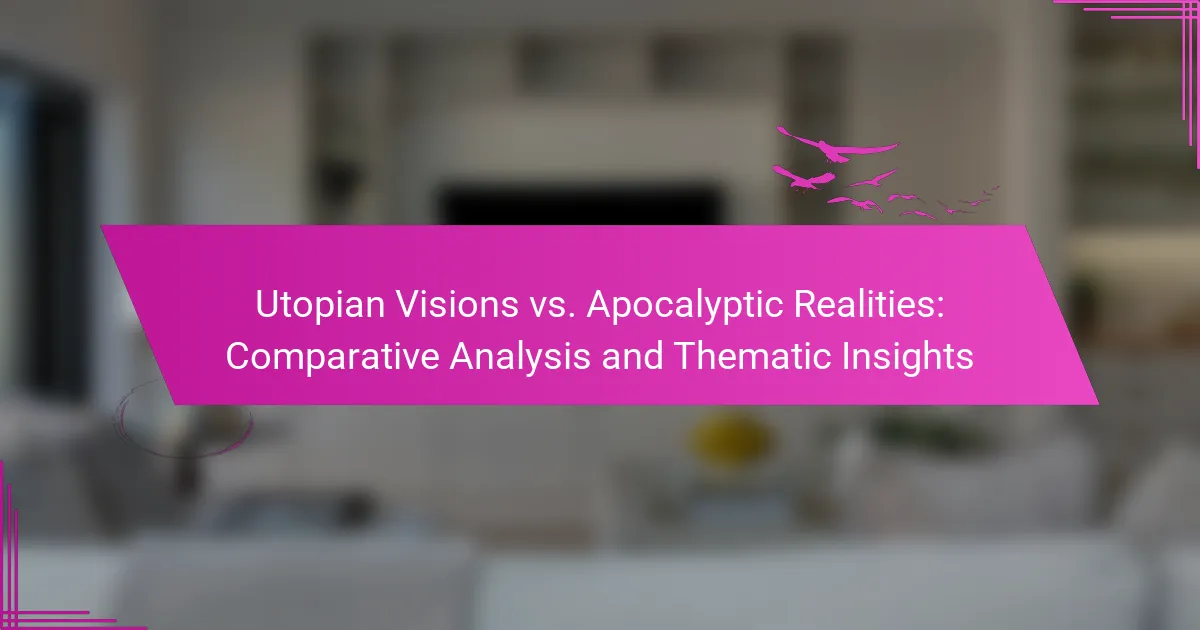Utopian visions and apocalyptic realities shape our understanding of the future. This analysis explores the idealistic aspirations of utopian concepts, the chaotic warnings of apocalyptic narratives, and their psychological impacts. It also examines how these frameworks influence political ideologies and societal values. Understanding these contrasting themes provides insight into the motivations driving contemporary cultural and policy discussions.
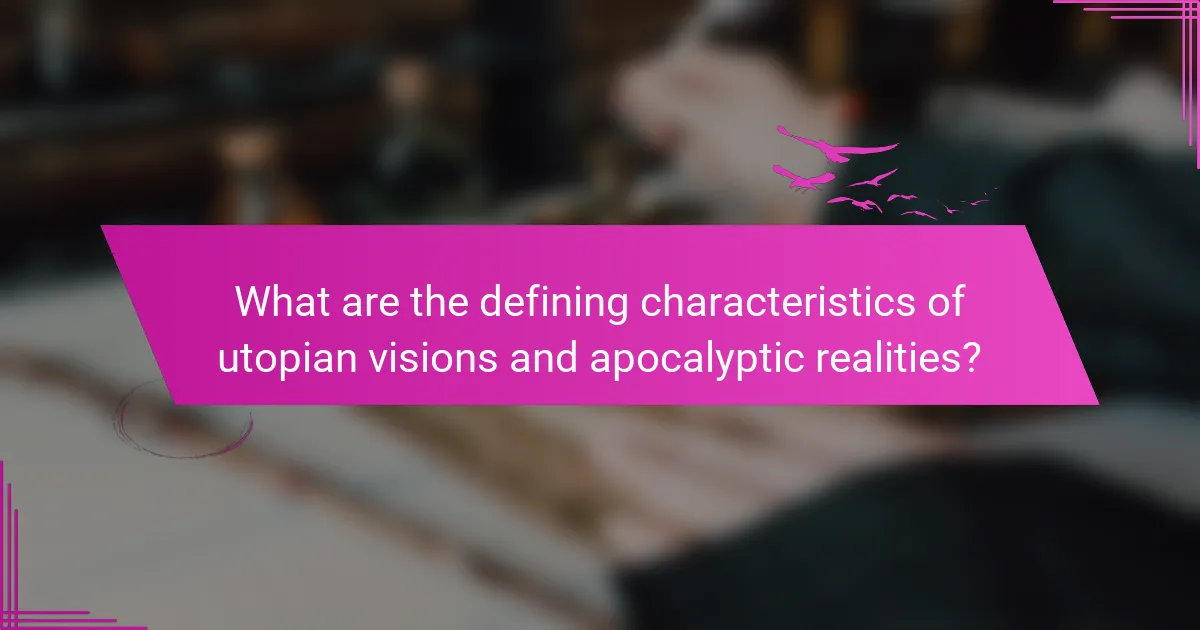
What are the defining characteristics of utopian visions and apocalyptic realities?
Utopian visions emphasize ideal societies characterized by harmony and equity, while apocalyptic realities depict dystopian outcomes marked by chaos and destruction. Utopian concepts often focus on community, sustainability, and technological advancements. In contrast, apocalyptic scenarios highlight societal collapse, environmental degradation, and existential threats. Utopian visions inspire hope and innovation, whereas apocalyptic realities serve as warnings against neglecting societal issues. Both themes reflect deep human concerns about the future and the impact of current actions.
How do cultural narratives shape perceptions of utopia?
Cultural narratives significantly influence perceptions of utopia by shaping ideals and aspirations. These narratives reflect societal values and historical contexts, often contrasting visions of a perfect world with current challenges. For instance, literature and art frequently depict utopian societies, inspiring hope and motivation for change. As a result, these cultural stories can drive movements towards social reform or highlight the dissonance between ideals and reality. The unique attribute of cultural narratives lies in their ability to resonate emotionally, making abstract concepts of utopia more relatable and tangible for individuals.
What common themes emerge in apocalyptic literature?
Common themes in apocalyptic literature include the struggle between hope and despair, societal collapse, and the search for redemption. These narratives often contrast utopian visions with harsh realities, reflecting human fears and aspirations. They explore the fragility of civilization and the resilience of the human spirit. Characters frequently confront moral dilemmas, highlighting themes of sacrifice and survival. The portrayal of nature’s wrath and the consequences of human actions serves as a cautionary tale, emphasizing the need for harmony with the environment.
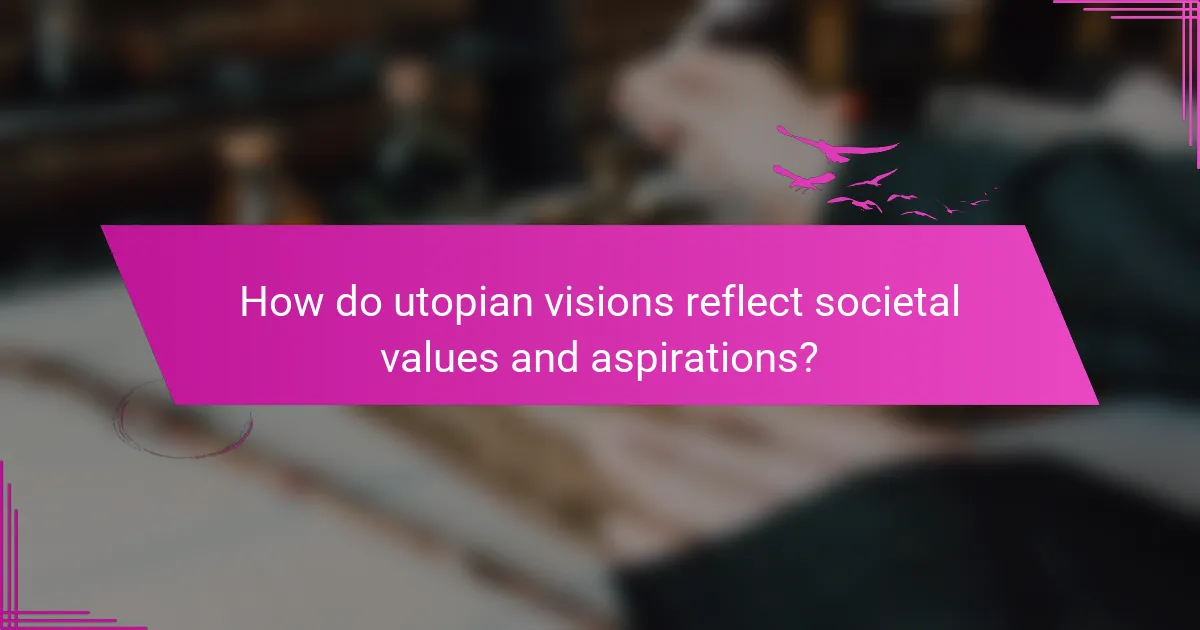
How do utopian visions reflect societal values and aspirations?
Utopian visions reflect societal values and aspirations by embodying ideals of harmony, equality, and progress. These visions often emerge during periods of social unrest, serving as a counterpoint to prevailing challenges. They inspire collective hope and motivate action towards positive change. For instance, the concept of a sustainable future resonates with current environmental concerns, highlighting a unique attribute of modern utopian thought. As a result, these visions not only mirror aspirations but also influence cultural narratives and policy directions.
Which historical examples illustrate successful utopian experiments?
Historical examples of successful utopian experiments include the Shakers, the Oneida Community, and the Kibbutz movement. These communities aimed for social harmony, economic cooperation, and shared resources.
The Shakers, founded in the 18th century, practiced communal living and celibacy, emphasizing craftsmanship and spiritual devotion. Their unique attribute was a strong focus on gender equality in leadership roles.
The Oneida Community, established in the 19th century, embraced complex marriage and communal property. Their rare attribute was the practice of “mutual criticism,” fostering personal growth through community feedback.
The Kibbutz movement in Israel began in the early 20th century, promoting collective agriculture and egalitarian principles. Its root attribute is shared ownership, which has evolved to include modern adaptations while maintaining core communal values.
What role do technological advancements play in shaping utopian ideals?
Technological advancements significantly influence utopian ideals by driving innovation and improving quality of life. These advancements foster social equity, environmental sustainability, and enhanced communication. For instance, renewable energy technologies support sustainable living, aligning with utopian visions of harmony with nature. Similarly, advancements in artificial intelligence can streamline processes, making resources more accessible. However, these technologies can also lead to dystopian realities, such as increased surveillance or job displacement. Balancing these outcomes is crucial for realizing utopian ideals while mitigating potential negative impacts.
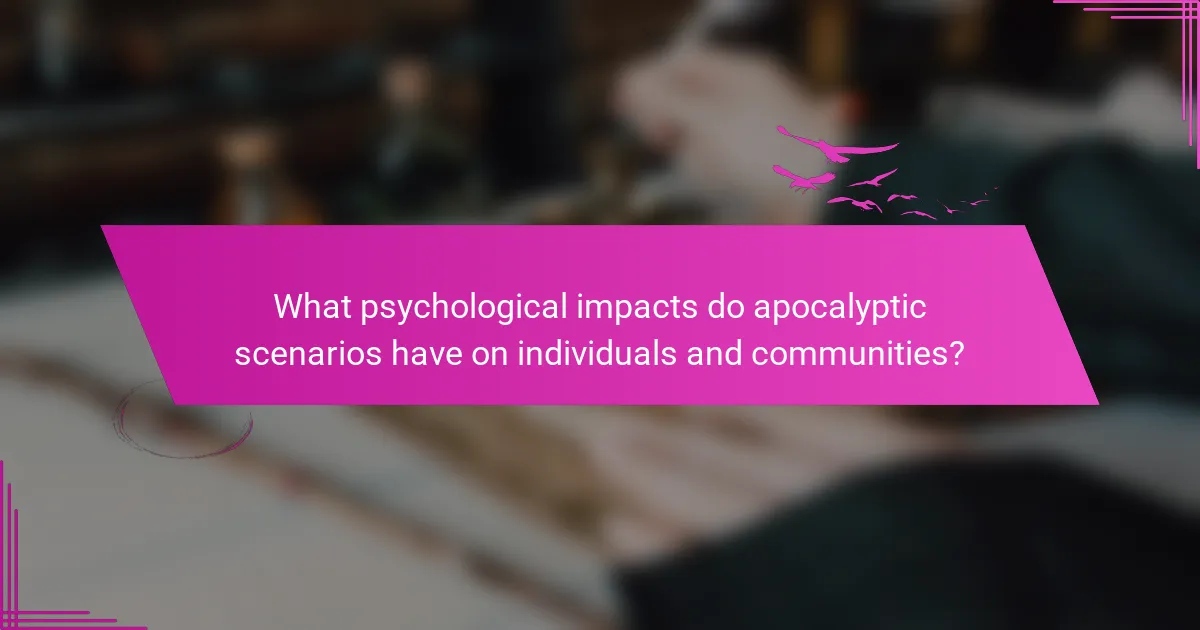
What psychological impacts do apocalyptic scenarios have on individuals and communities?
Apocalyptic scenarios can lead to heightened anxiety, social isolation, and existential dread in individuals and communities. These psychological impacts often manifest as a collective sense of fear and uncertainty about the future.
Additionally, apocalyptic narratives can foster a sense of hopelessness, diminishing motivation for proactive behaviors. Communities may experience fragmentation as individuals withdraw or adopt radical beliefs in response to perceived threats.
Conversely, some individuals may find resilience and solidarity in these scenarios, leading to the formation of support networks. This duality highlights the complex psychological landscape shaped by apocalyptic visions and realities.
How do fear and hope coexist in responses to potential apocalyptic events?
Fear and hope can coexist as psychological responses to potential apocalyptic events, influencing human behavior and societal dynamics. Fear often drives individuals to prepare for worst-case scenarios, while hope inspires resilience and the pursuit of positive outcomes. This duality can manifest in utopian visions that emerge from the desire to overcome dire circumstances, contrasting with the stark realities of potential destruction.
In literature and media, these themes are prevalent, illustrating how characters navigate the tension between despair and optimism. For example, dystopian narratives frequently depict societies grappling with fear, yet they often highlight the hope for redemption or a better future. This interplay shapes cultural discourse on survival, ethics, and community, emphasizing the need for balance in our responses to existential threats.
Ultimately, understanding how fear and hope coexist enriches our analysis of human resilience in the face of potential apocalyptic events, revealing the complexities of emotional responses that drive societal action.
What coping mechanisms emerge in societies facing apocalyptic narratives?
Coping mechanisms in societies facing apocalyptic narratives include resilience, community solidarity, and alternative belief systems. These responses often emerge as individuals seek hope and meaning in uncertain times. For instance, communities may engage in grassroots movements to foster support networks. Additionally, some individuals turn to spirituality or new ideologies to cope with existential fears. These mechanisms reflect a unique attribute of human adaptability in the face of crisis.
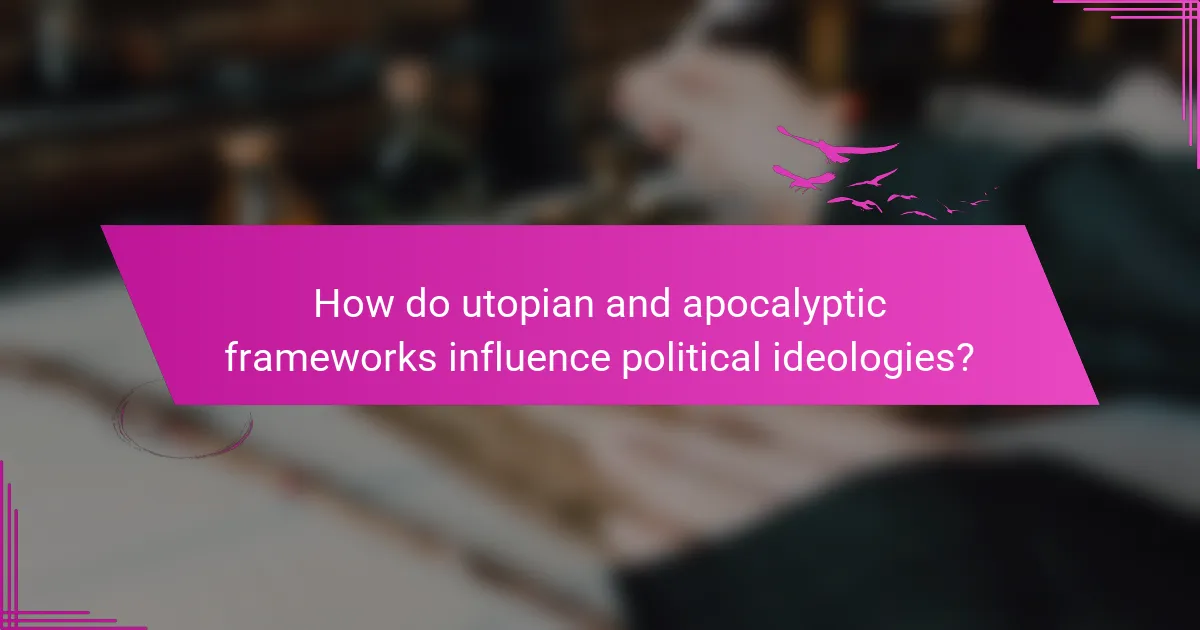
How do utopian and apocalyptic frameworks influence political ideologies?
Utopian and apocalyptic frameworks significantly shape political ideologies by influencing visions of society’s potential and fears of its collapse. Utopian visions promote idealized societal structures, encouraging progressive policies and reform. In contrast, apocalyptic narratives invoke urgency, often leading to reactionary politics focused on survival and control. These contrasting perspectives drive political discourse, shaping policies around social justice, environmental action, and governance. Utopian ideals foster hope and inclusivity, while apocalyptic views can lead to division and authoritarianism. Understanding these influences helps clarify the motivations behind various political movements.
Which political movements have drawn inspiration from utopian concepts?
Various political movements have drawn inspiration from utopian concepts, including socialism, communism, and anarchism. These ideologies envision ideal societies where equality and communal ownership prevail. For example, socialism seeks to establish a society that prioritizes social welfare and economic equality. Communism aims for a classless society, eliminating private property. Anarchism envisions a stateless society where individuals govern themselves. Each movement reflects distinct interpretations of utopia, influencing their strategies and goals.
What are the implications of apocalyptic thinking on policy-making?
Apocalyptic thinking can significantly hinder effective policy-making by fostering fear and paralysis. This mindset often leads to short-term solutions that neglect long-term sustainability. Policymakers may prioritize immediate crisis responses over comprehensive strategies, resulting in reactive rather than proactive governance. Additionally, apocalyptic narratives can polarize public opinion, complicating consensus-building essential for impactful policy.

What unique attributes differentiate various utopian and apocalyptic visions?
Utopian visions often emphasize harmony and ideal societies, while apocalyptic realities focus on chaos and destruction. Unique attributes include the idealistic nature of utopian concepts, which propose perfect social systems, contrasting with the dystopian elements of apocalyptic scenarios that highlight societal collapse. Utopian narratives frequently feature technological advancements as solutions, whereas apocalyptic visions may depict technology as a catalyst for downfall. Additionally, utopian perspectives tend to inspire hope and motivation, while apocalyptic narratives evoke fear and caution.
How do regional contexts shape specific utopian models?
Regional contexts significantly influence utopian models by shaping cultural values, social structures, and historical experiences. Different regions prioritize distinct attributes based on their unique challenges and aspirations.
For instance, Scandinavian countries emphasize social equality and environmental sustainability in their utopian visions, reflecting their strong welfare systems and commitment to green policies. In contrast, regions facing economic hardship may focus on economic stability and communal support as key attributes of their utopian ideals.
Historical events also play a crucial role. Areas with a history of conflict may envision utopias centered on peace and reconciliation, while regions with colonial pasts might prioritize self-determination and cultural revival.
These variations illustrate how regional contexts create diverse utopian models, each tailored to specific societal needs and aspirations.
What distinguishes secular apocalyptic narratives from religious ones?
Secular apocalyptic narratives differ from religious ones primarily in their basis in human experience rather than divine prophecy. Secular narratives often reflect societal fears and existential threats, while religious narratives are rooted in spiritual beliefs and divine intervention.
Secular apocalyptic themes frequently focus on technological collapse, environmental disasters, or political upheaval. These reflect contemporary anxieties and are often framed within a context of human agency and responsibility. In contrast, religious narratives typically emphasize a moral reckoning and the ultimate fulfillment of divine plans.
Furthermore, secular apocalyptic stories may offer a vision of rebirth or renewal without a divine savior, highlighting human resilience. Religious narratives, however, often promise salvation through faith and adherence to spiritual principles. This distinction shapes how each narrative influences societal perceptions of hope and despair in the face of potential calamity.
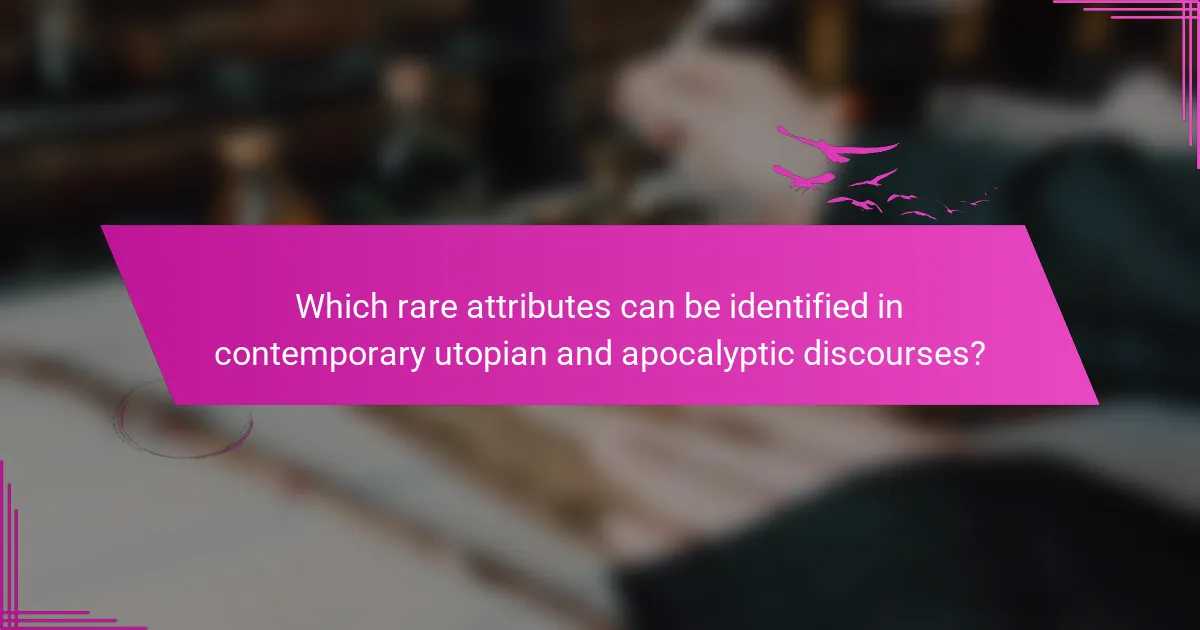
Which rare attributes can be identified in contemporary utopian and apocalyptic discourses?
Contemporary utopian and apocalyptic discourses reveal rare attributes such as the idealization of technology in utopian visions and the emphasis on environmental collapse in apocalyptic narratives. Utopian discourses often incorporate unique attributes like community resilience and social equity, while apocalyptic narratives may highlight rare traits such as existential dread and societal fragmentation. These contrasting perspectives shape our understanding of future possibilities.
What unconventional utopian ideas are gaining traction in modern society?
Unconventional utopian ideas gaining traction include eco-communities, digital nomadism, and decentralized governance. These concepts challenge traditional societal structures and promote sustainability, flexibility, and participatory decision-making.
Eco-communities focus on self-sufficiency and environmental harmony. They emphasize shared resources and renewable energy, aiming for minimal ecological impact. Digital nomadism allows individuals to work remotely while traveling, fostering a lifestyle that prioritizes freedom and exploration. Decentralized governance advocates for community-led decision-making, enhancing transparency and local empowerment.
These ideas reflect a shift towards innovative solutions addressing contemporary challenges, showcasing a desire for more equitable and resilient societal frameworks.
How do niche apocalyptic scenarios reflect specific cultural anxieties?
Niche apocalyptic scenarios reveal cultural anxieties by reflecting societal fears and values. These narratives often illustrate concerns about technological advancement, environmental degradation, and social collapse. For example, dystopian tales emphasize distrust in government and corporate power, mirroring contemporary skepticism. Additionally, the portrayal of survival often highlights individualism versus community, showcasing the tension between self-reliance and collective support. Such themes resonate with audiences, allowing exploration of their deepest fears and aspirations.
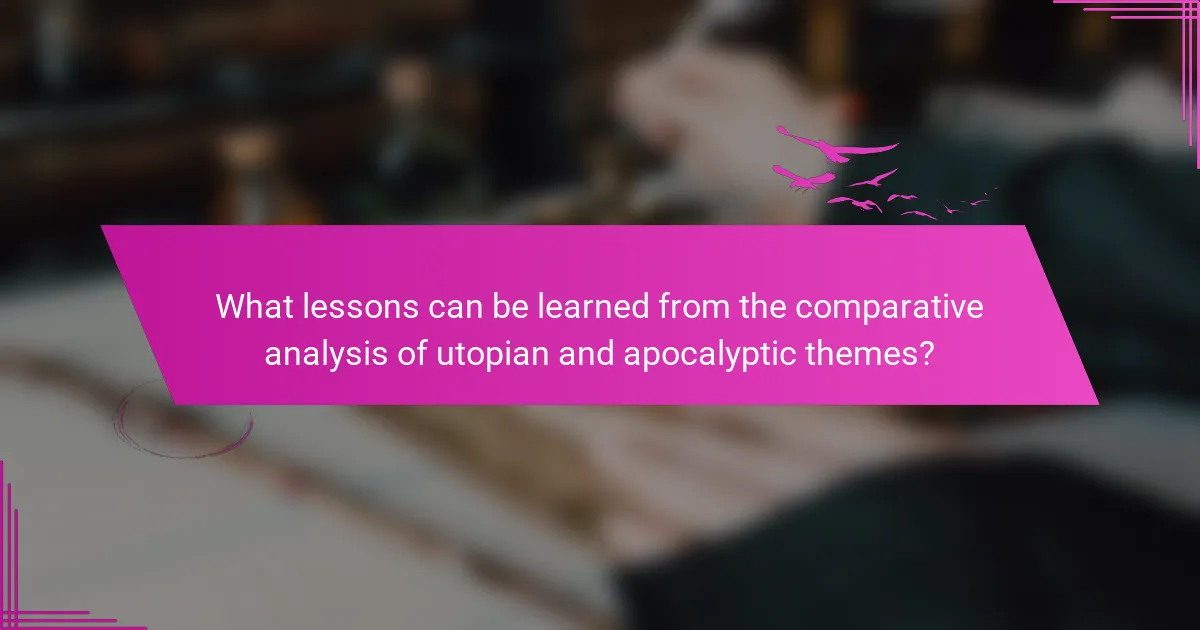
What lessons can be learned from the comparative analysis of utopian and apocalyptic themes?
The comparative analysis of utopian and apocalyptic themes reveals significant lessons about human aspirations and fears. Utopian visions often reflect idealistic goals for societal improvement, emphasizing cooperation and harmony. In contrast, apocalyptic narratives highlight existential threats and the consequences of human actions. This dichotomy illustrates how hope and despair shape cultural perspectives, influencing social behavior and policy decisions. Understanding these themes can guide contemporary discussions on sustainability and ethical governance.
How can understanding these narratives inform future societal planning?
Understanding narratives of utopian visions and apocalyptic realities can guide future societal planning by highlighting potential pathways and pitfalls. Utopian narratives inspire innovation and collaboration, while apocalyptic themes emphasize caution and resilience.
Integrating insights from both perspectives fosters balanced strategies. For example, incorporating sustainable practices from utopian ideals can mitigate risks identified in apocalyptic scenarios.
Additionally, these narratives can inform policy-making by revealing societal values and priorities. Engaging communities in discussions about these themes can enhance collective foresight and adaptability.
Incorporating diverse viewpoints ensures comprehensive planning, addressing both aspirations and challenges. This approach can lead to more resilient, forward-thinking societies.
What best practices can be adopted to balance utopian aspirations with realistic concerns?
Balancing utopian aspirations with realistic concerns requires a pragmatic approach that incorporates critical thinking and adaptability. Embrace incremental changes while setting achievable goals. Engage diverse stakeholders to foster collaboration and gather varied perspectives. Prioritize transparency to build trust and encourage open dialogue. Assess potential risks and benefits to inform decision-making processes. Regularly evaluate progress to adjust strategies as needed.
